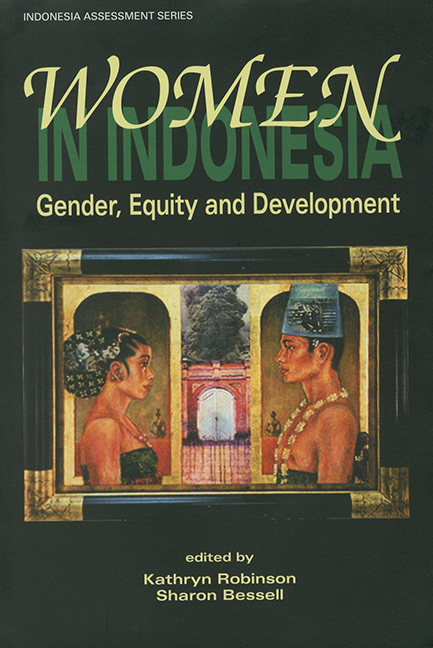Book contents
- Frontmatter
- Contents
- Tables
- Figures
- Contributors
- Acknowledgments
- Glossary
- Prologue
- 1 Introduction to the Issues
- 2 The Mega Factor in Indonesian Politics: A New President or a New Kind of Presidency?
- 3 The Downfall of President Abdurrahman Wahid: A Return to Authoritarianism?
- 4 The Year in Review: From Blind Man's Bluff to Mega Expectations
- 5 Further Comments on the Economy, with a Gender Perspective
- 6 Institution Building: An Effort to Improve Indonesian Women's Role and Status
- Commentary
- 7 Feminism in Indonesia in an International Context
- 8 Gay and Lesbi Subjectivities, National Belonging and the New Indonesia
- 9 And the Winner Is … Indonesian Women in Public Life
- 10 Indonesian Women Artists: Transcending Compliance
- 11 Literature, Mythology and Regime Change: Some Observations on Recent Indonesian Women's Writing
- 12 Women and the Labour Market during and after the Crisis
- 13 Women's International Labour Migration
- 14 Customary Institutions, Syariah Law and the Marginalisation of Indonesian Women
- 15 Women's Grassroots Movements in Indonesia: A Case Study of the PKK and Islamic Women's Organisations
- 16 Women's Activism against Violence in South Sulawesi
- 17 Gender Mainstreaming and Sex-disaggregated Data
- 18 The Changing Indonesian Household
- 19 Women, Family Planning and Decentralisation: New Variations on Old Themes
- 20 Men, Women and Community Development in East Nusa Tenggara
- References
- Index
- INDONESIA ASSESSMENT SERIES
17 - Gender Mainstreaming and Sex-disaggregated Data
Published online by Cambridge University Press: 21 October 2015
- Frontmatter
- Contents
- Tables
- Figures
- Contributors
- Acknowledgments
- Glossary
- Prologue
- 1 Introduction to the Issues
- 2 The Mega Factor in Indonesian Politics: A New President or a New Kind of Presidency?
- 3 The Downfall of President Abdurrahman Wahid: A Return to Authoritarianism?
- 4 The Year in Review: From Blind Man's Bluff to Mega Expectations
- 5 Further Comments on the Economy, with a Gender Perspective
- 6 Institution Building: An Effort to Improve Indonesian Women's Role and Status
- Commentary
- 7 Feminism in Indonesia in an International Context
- 8 Gay and Lesbi Subjectivities, National Belonging and the New Indonesia
- 9 And the Winner Is … Indonesian Women in Public Life
- 10 Indonesian Women Artists: Transcending Compliance
- 11 Literature, Mythology and Regime Change: Some Observations on Recent Indonesian Women's Writing
- 12 Women and the Labour Market during and after the Crisis
- 13 Women's International Labour Migration
- 14 Customary Institutions, Syariah Law and the Marginalisation of Indonesian Women
- 15 Women's Grassroots Movements in Indonesia: A Case Study of the PKK and Islamic Women's Organisations
- 16 Women's Activism against Violence in South Sulawesi
- 17 Gender Mainstreaming and Sex-disaggregated Data
- 18 The Changing Indonesian Household
- 19 Women, Family Planning and Decentralisation: New Variations on Old Themes
- 20 Men, Women and Community Development in East Nusa Tenggara
- References
- Index
- INDONESIA ASSESSMENT SERIES
Summary
THE GENDER GAP IN INDONESIA
In Indonesia, women comprise slightly more than half the population. Yet they remain seriously underrepresented in higher education, political decision-making, the judiciary and upper echelons of the civil service. In this chapter I examine what sex-disaggregated statistics tell us about gender equity and development in Indonesia. I then discuss policy responses to the underrepresentation of women, focusing on the concept of gender mainstreaming, which became part of national development policy under a Presidential Instruction issued in 2000. Finally, I examine the various data sources necessary for gender mainstreaming, and the important role played by the Central Statistics Agency (BPS) in the collection and dissemination of data. I argue that reliable, sex-disaggregated data are central to gender mainstreaming and, ultimately, to promoting gender equality.
Sex composition in Indonesia has not changed much over the last decade: on average there are around 99 males for every 100 females. The sex ratio, however, is not equal across all age groups: it is over 90 for people aged under 60 years but lower than this for older age cohorts, implying that women have a longer life expectancy than men. Based on the preliminary results of the 2000 population census, there are around 102 million females in Indonesia and 101 million males (BPS 2001a). Through their numbers alone, then, women have a right to be reckoned with.
Women remain less well educated than men. Fewer women – especially adult women – than men are able to read and write, although this is changing quite quickly. In 1990 illiteracy among women aged 10–44 years stood at about 6.2 per cent (compared with 3.1 per cent for men), but by 2000 this had fallen to 5.2 per cent (still much higher than the rate for men of 2.7 per cent) (BPS 2001b). The above figures reflect the increased opportunity for women to participate in education, even though their literacy rates continue to lag behind those of men.
The country's development policies on education were not intentionally designed to favour girls, but have proved successful in improving their access to schooling. In early 1974, in line with a Presidential Instruction on primary education, the number of primary schools in each village was increased.
- Type
- Chapter
- Information
- Women in IndonesiaGender, Equity and Development, pp. 209 - 218Publisher: ISEAS–Yusof Ishak InstitutePrint publication year: 2002



